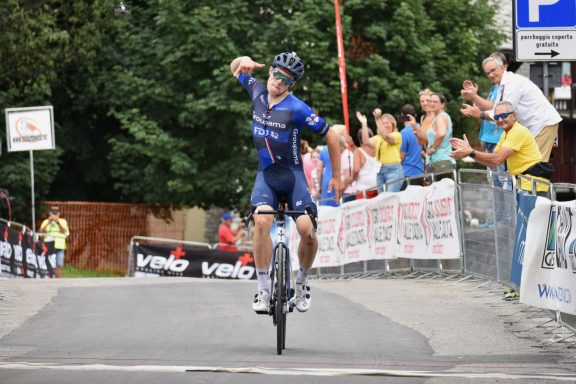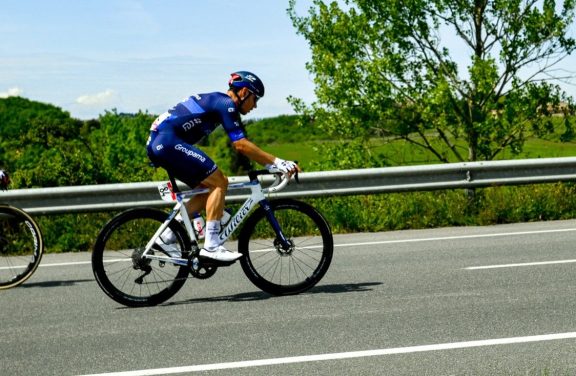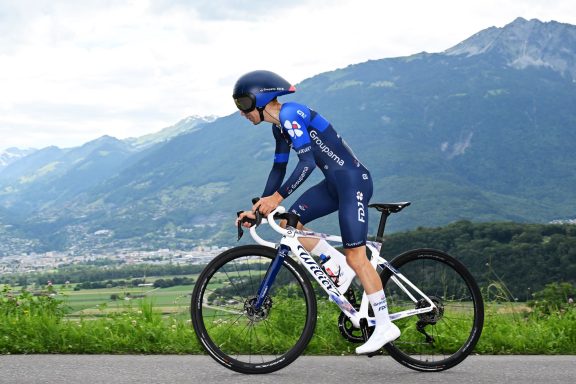The Groupama-FDJ cycling team is back in racing, at least virtually. From April 22 to 26, some of our riders will take part in “The Digital Swiss 5”, an on-line event, set up by the Tour de Suisse organizers, during which riders will compete remotely thanks to their ‘’smart’’ trainers. Anthony Bouillod, one of the team’s coaches, tried to answer the questions that obviously come alongside this event.
WHAT?
This is a race that will take place on the Rouvy platform, where some of the Tour de Suisse 2020’s routes have been imported. There will be five stages: number 1, 3 and 5 should suit the climbers, number 2 and 4 will have more a medium profile, flatter. As far as we know, the three climbing stages will end on a summit finish. Obviously, it is impossible to replicate road race distances. The shortest stage will therefore be 26km long and the longest one will be 50km. The organizers expect an hour racing more or less, but it should go from 45 minutes up to 1h15 depending on the stage. Teams will line-up three riders on each stage and will be able to change them, or not, from race to race. As it will happen for sure and that no rider will do the five days, there will be stage classifications but not a general ranking. We don’t know yet if they will make a team classification. There will be 19 teams, including 17 from the WorldTour, so the pelotons should theoretically be made of 57 riders. One of the three riders on each team will normally have a webcam for broadcast.
WHO?
Bruno Armirail, Kilian Frankiny, David Gaudu, Simon Guglielmi, Stefan Küng, Matthieu Ladagnous, Fabien Lienhard, Tobias Ludvigsson, Valentin Madouas, Rudy Molard, Sébastien Reichenbach, Benjamin Thomas
We asked among our riders who was interested in taking part in this event. They were twelve of them. This was done on a voluntary basis. Some riders like the indoor trainers, or at least stand it well, others less. Some enjoy virtual racing, others a bit less. Above all, we didn’t want to force the riders and to select anyone who did not feel like doing this kind of race at all. In the end, we had no trouble finding our 12 guys. Some are already very used to these practices, these races, on this platform or others. Then, we put them according to their profile and that of the stages so that it could “match” in the best possible way. However, there is a question mark on tactics. If the platform we use includes drafting, tactics necessarily come into play. On Rouvy, there is no drafting. From this point of view, it’s a bit tricky as it can have a real influence on tactics.
WHY?
We chose to take part in the event, especially with regard to the organizer, who made the effort to set this up. All of the organizers haven’t done it so the least we could do was to ask our riders if they were interested. In this quite unprecedented period, we must also find elements so that the riders can find some pleasure in their practice. As coaches, we therefore need to suggest them, not impose, new things that could please them and could ultimately make their daily training easier. These platforms and virtual races are an integral part of it. Some would rather make specific and planned exercises; others are keener on training on platforms like Rouvy or Zwift. In any case, the general idea is to find a good balance so that the riders can stay fit without enduring too much constraint. Those who enjoy virtual platform training volunteered quite easily to participate in this event. For them, the idea of pleasure will therefore be essential.
GOAL?
Performance-wise, results are not a priority. For us coaches, the main goal is that riders can both have good stimulation in their training and also have fun putting on this stimulation. This has a dual benefit: they would train well, without having a lot of constraints. If we manage to lengthen this balance, it will be good for us when it will be time to resume serious training on the road. Riders will then be mentally and physically fresh and will be able to go out and do good workloads to prepare the rest of the season. Therefore, they did not have any specific preparation for this race, but they are all riders used to riding, stimulating and racing on virtual platforms. As a result, they rather are in good shape. We can say that the event gets integrated into the training program, not the other way around. The riders will have their road bike and there is no particular change to notice. However, we do know that riders sweat a lot more on indoor trainers than on the road. So it will be necessary to be careful about adjusting to water and nutritional intakes.
ISSUES?
The biggest problem, which the organizer cannot handle, is the power meter and smart trainer’s calibration. The resistance is established according to the power level delivered by the trainer, which we don’t know the calibration. For instance, you can have an overestimating trainer, an underestimating one, and the difference on the road – or on the screen – will be made more on this than on the rider’s pure values. It is also for this reason that we see unknown riders being able to ride and beat pros on Zwift. Because of these various calibrations, we are not shielded from big differences in performance, including on the virtual Tour de Suisse. On our side, we check if the power meter of the road bike and that of the trainer are matching. Does everyone do it? I don’t know. Everyone does what he wants, it’s not an official competition. Also, when you access a platform, you can connect either your trainer or the chainset. If the smart trainer provides false watts, you can easily connect the chainset instead. Will everyone think about it? Would a rider rather think, “I’m going to connect my trainer because it produces 10 watts more than my chainset”? This is complicated, and can’t be controlled by the organizer. Similarly, in the mountains, what will influence the rider’s travel speed is watts/kg. It therefore depends on both the accuracy of the power meter and the accuracy of the weight given by the rider. If one gives a weight three kilos lower than the reality, it will obviously influence the performance. Many things can interfere and skew the actual performance. It is very complicated to cope with and that is also why we do not put pressure on the riders in terms of results. The focus rather is on having fun.



No comment